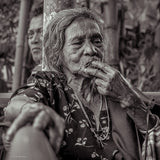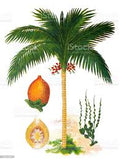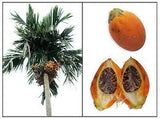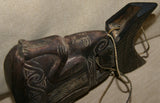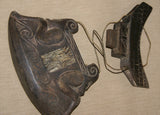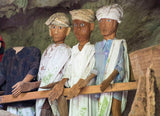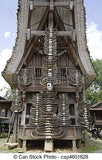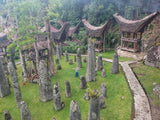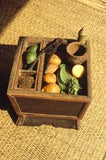HAND CARVED WOODEN BETEL QUID CONTAINER PURSE, TORAJA PEOPLE, SULAWESI. BETEL LIME HABIT RECEPTACLE WITH MOTIFS OF ANCESTORS & BUFFALO BONE DECORATIONS CREATED IN THE SHAPE OF TRADITIONAL TONGKONAN HOUSES. COLLECTED IN THE FIELD
UNIQUE HAND CARVED (BETEL LIME HABIT) RECEPTACLE WITH LID, A MAN PURSE OF SORTS, WITH A HAND TWINED NATURAL FIBER STRAP HANDLE, COLLECTED IN THE FIELD FROM A TORAJA TRIBAL MEMBER. THE UNUSUAL CARRY-ON WAS CREATED IN THE SHAPE OF THE TRADITIONAL HOUSES OF THE REGION, CALLED TONGKONAN.
South Sulawesi, Indonesia.
ITEM 292A: SIZE 8"X9"X2"
LOOK AT PHOTOS CAREFULLY TO BE SATISFIED, CONDITION IS CLEARLY SEEN.
Tana Toraja (also referred to as Toraja) is a region in South Sulawesi, Indonesia. It is a landlocked regency and it is famous for the Torajan homes (Tongkonan) and traditional funeral ceremonies. The Toraja are an ethnic group indigenous to a mountainous region of South Sulawesi, Indonesia called Tana Toraja, which translates as “Land of the Toraja.” Before the 20th century, most Torajans lived in autonomous villages and the vast majority practiced animism, the belief in the existence of individual spirits that inhabit natural objects and phenomena. In effect, they were untouched by the outside world.
Tongkonan houses, as this wooden purse, have a distinguishing boat-shaped and oversized saddleback roof (Like most of Indonesia's Austronesian-based traditional architecture, tongkonan are built on piles).
Tongkonan is the traditional ancestral house (or Rumah adat) of the Toraja people seen on many of these photos. The roof is curved like boat, consisting of a bamboo. The funeral ceremonies of Tana Toraja are among the most elaborate in the world. There is a season for the ceremonies, so the funerals are held weeks, months, or sometimes years after death. The mummified body will be kept in the family home until funds are raised to hold an appropriate ceremony. The funerals are held in stages, a big funeral has as many as three hundred buffalo sacrifices. The Torajans are a Christian minority (with a dash of animism), so pigs are also on the menu in this part of Indonesia. It is a very festive ceremony.
Wonderful old wood betel container (man purse) to add to any Betel habit collection: these items are highly collectible and used in this part of Asia by Shamans for herbs, magic powders, and betel lime habit and by betel nut users etc….
The fruit of the areca palm (Areca catechu) is chewed together with lime and betel pepper as a stimulant by peoples of the East and Papua New Guinea, among other places. Chewing it blackens the teeth and stains the mouth deep red.
Betel is one of the oldest intoxicants and was the most popular until the beginning of this century. Betel is classified as a mild stimulant similar to coffee. It has a multitude of meanings and uses, and the habit of chewing betel is well integrated into the different communities of the Golden Triangle as most of Asia.
Betel consists of three main ingredients. The leaf comes from a creeper called the betel plant. The second ingredient is a nut from areca palm, and the third is lime that is made from ground seashells or artificially manufactured. These ingredients form the betel quid that is chewed. In addition, other items such as tobacco, spices or medicinal plants may be added as desired.
In order to make a betel quid, you need a betel set. This consists of a number of containers for the different ingredients, a cutter or knife to cut up the areca nut and a mortar and pestle to mix the ingredients together. These elements are often carried in lacquer or metal boxes and can be very elaborately decorated.
Betel chewing causes a rapid production of saliva of a strong red color. After many years one’s teeth become black as a result. Red lips and black teeth were previously thought to be a sign of beauty, especially for young women. "Only dogs, ghosts and Europeans had white teeth!"
Betel played an important role in social interaction. A betel set was placed in front of a guest as a gesture of good manners. If the betel set was removed, it meant that the visit should be terminated. In courtship a gift of a betel quid was a sign of affection.
Betel was used extensively in rituals. In exorcism rituals betel was used as a means of transferring magical powers in order to drive out evil spirits. At marriage rituals, the couple was given a betel set for two symbolising unity and fertility. In addition, the ancestral spirits received regular offerings of betel from the living.
Those who chew betel have always claimed that it has positive effects on the body. Western medicine has since verified this. Chewing betel protects teeth from bacteria and aids in digestion. The combination of ingredients in the betel quid actually kills a number of harmful stomach parasites.
Betel was very popular among all ethnic groups in Southeast Asia but is now only use by elderly women. Western ideals about appearances (white teeth) and hygiene (rules against spitting and the spread of diseases) have influenced local attitudes. The use of betel has decreased dramatically over the last 50 years and has been replaced by tobacco.
All our collector and rare items come with pages and pages of research about provenance, and with history of the tribes and photos as well, depending on item and whenever possible. When shipping internationally, we group ship multiple purchases to save you money. If you have any questions or want to see research conducted on this piece and photos of tribes, let us know.






























